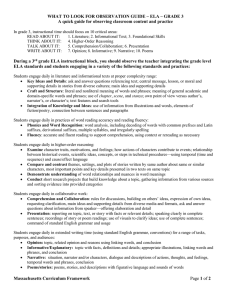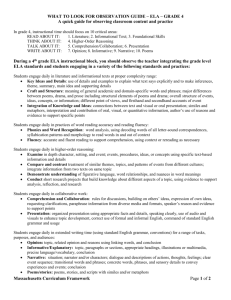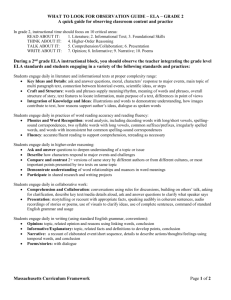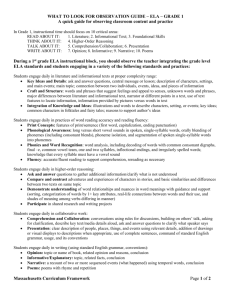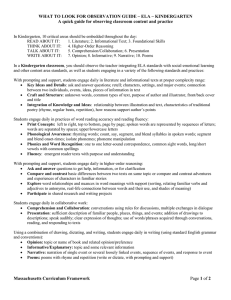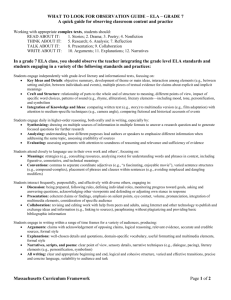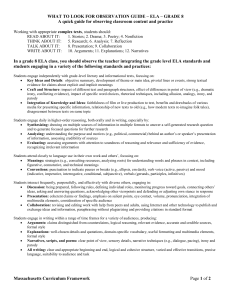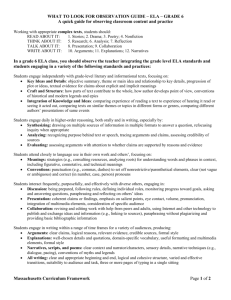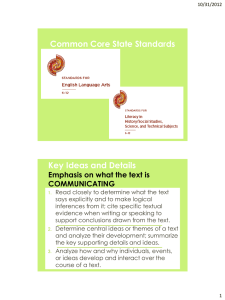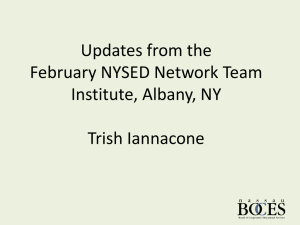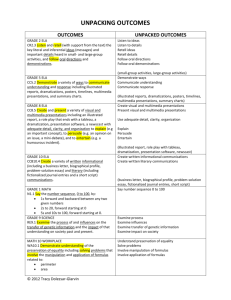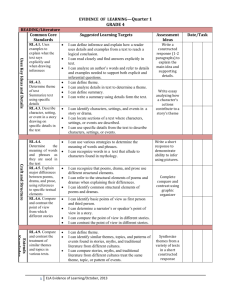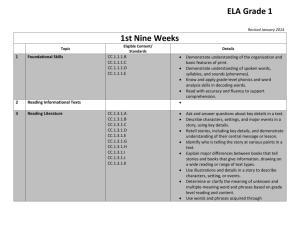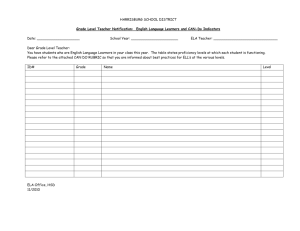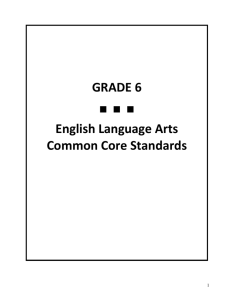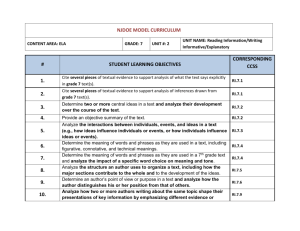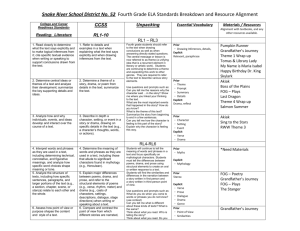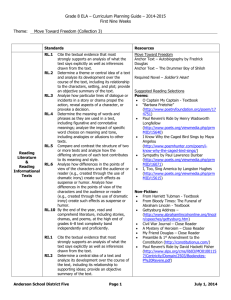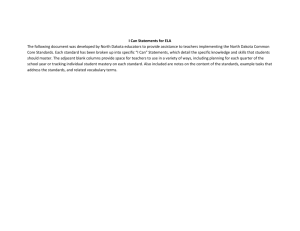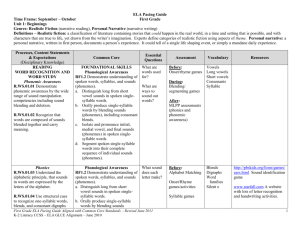What To Look For ELA Grade 5
advertisement
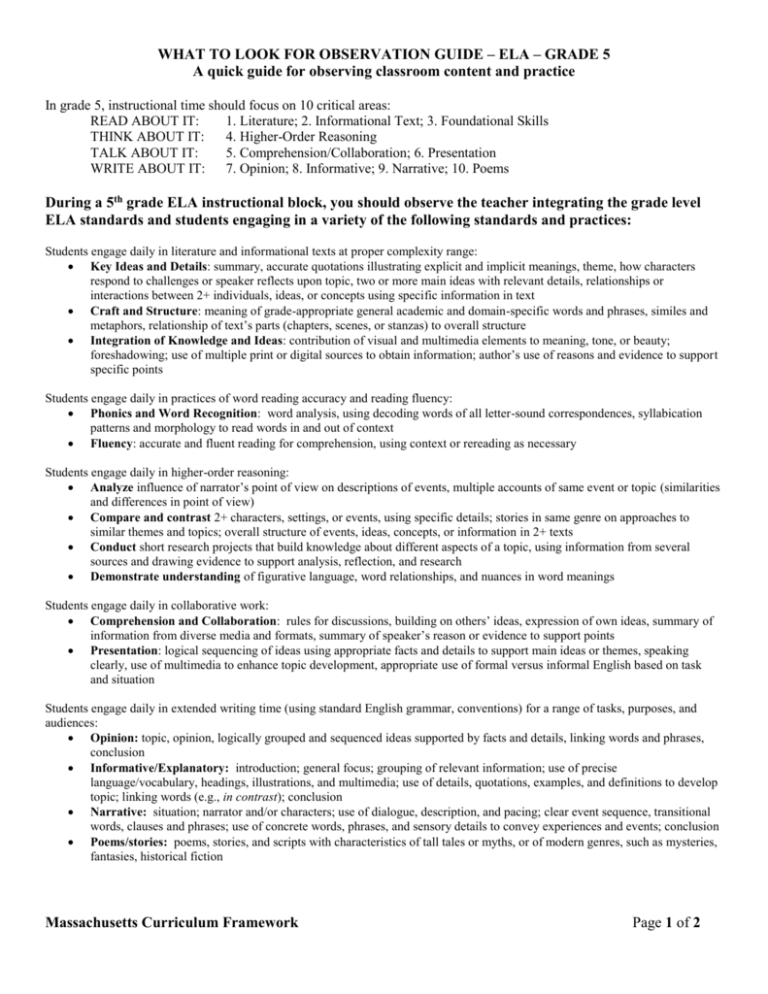
WHAT TO LOOK FOR OBSERVATION GUIDE – ELA – GRADE 5 A quick guide for observing classroom content and practice In grade 5, instructional time should focus on 10 critical areas: READ ABOUT IT: 1. Literature; 2. Informational Text; 3. Foundational Skills THINK ABOUT IT: 4. Higher-Order Reasoning TALK ABOUT IT: 5. Comprehension/Collaboration; 6. Presentation WRITE ABOUT IT: 7. Opinion; 8. Informative; 9. Narrative; 10. Poems During a 5th grade ELA instructional block, you should observe the teacher integrating the grade level ELA standards and students engaging in a variety of the following standards and practices: Students engage daily in literature and informational texts at proper complexity range: Key Ideas and Details: summary, accurate quotations illustrating explicit and implicit meanings, theme, how characters respond to challenges or speaker reflects upon topic, two or more main ideas with relevant details, relationships or interactions between 2+ individuals, ideas, or concepts using specific information in text Craft and Structure: meaning of grade-appropriate general academic and domain-specific words and phrases, similes and metaphors, relationship of text’s parts (chapters, scenes, or stanzas) to overall structure Integration of Knowledge and Ideas: contribution of visual and multimedia elements to meaning, tone, or beauty; foreshadowing; use of multiple print or digital sources to obtain information; author’s use of reasons and evidence to support specific points Students engage daily in practices of word reading accuracy and reading fluency: Phonics and Word Recognition: word analysis, using decoding words of all letter-sound correspondences, syllabication patterns and morphology to read words in and out of context Fluency: accurate and fluent reading for comprehension, using context or rereading as necessary Students engage daily in higher-order reasoning: Analyze influence of narrator’s point of view on descriptions of events, multiple accounts of same event or topic (similarities and differences in point of view) Compare and contrast 2+ characters, settings, or events, using specific details; stories in same genre on approaches to similar themes and topics; overall structure of events, ideas, concepts, or information in 2+ texts Conduct short research projects that build knowledge about different aspects of a topic, using information from several sources and drawing evidence to support analysis, reflection, and research Demonstrate understanding of figurative language, word relationships, and nuances in word meanings Students engage daily in collaborative work: Comprehension and Collaboration: rules for discussions, building on others’ ideas, expression of own ideas, summary of information from diverse media and formats, summary of speaker’s reason or evidence to support points Presentation: logical sequencing of ideas using appropriate facts and details to support main ideas or themes, speaking clearly, use of multimedia to enhance topic development, appropriate use of formal versus informal English based on task and situation Students engage daily in extended writing time (using standard English grammar, conventions) for a range of tasks, purposes, and audiences: Opinion: topic, opinion, logically grouped and sequenced ideas supported by facts and details, linking words and phrases, conclusion Informative/Explanatory: introduction; general focus; grouping of relevant information; use of precise language/vocabulary, headings, illustrations, and multimedia; use of details, quotations, examples, and definitions to develop topic; linking words (e.g., in contrast); conclusion Narrative: situation; narrator and/or characters; use of dialogue, description, and pacing; clear event sequence, transitional words, clauses and phrases; use of concrete words, phrases, and sensory details to convey experiences and events; conclusion Poems/stories: poems, stories, and scripts with characteristics of tall tales or myths, or of modern genres, such as mysteries, fantasies, historical fiction Massachusetts Curriculum Framework Page 1 of 2 WHAT TO LOOK FOR OBSERVATION GUIDE – ELA – GRADE 5 ELA What to Look For Guide The practices below, which fall under Standards I and II of the MA Model Teacher Rubric, should be evident in planning and instruction. Any particular lesson will demonstrate some of the practices, not all. For each lesson, artifacts or observables might include: lesson plan, tasks and assessments, teacher instruction, student discussion and behavior, or student work. Student Practices Teacher Practices Standards-based Learning Read and comprehend complex texts (or excerpts) from a variety of text structures. Read text closely, examining textual evidence and discerning deep meaning. Cite text-based evidence when writing, speaking, and answering questions about text. Engage in meaningful writing that is aligned with grade level standards. Standards-based Instruction Ownership of Learning Question, contribute, and collaborate throughout the lesson. Engage in discourse, using higher-order reasoning, with their teacher(s) and peers to develop a deeper understanding of content. Provide a valid and meaningful rationale for what they are learning and why. Communicate standards (objectives) in a clear, explicit way. Communicate and support language objectives for English Language Learners (ELLs) in a clear, explicit way. Teach standards in context and integrate the standards throughout the day. Explicitly connect previously taught objectives to current lesson. Provide mentor texts, exemplars, and rubrics. Research-based Instruction Provide multiple authentic opportunities for students to practice new skills and vocabulary. Explain concepts in multiple ways to facilitate understanding. Provide explicit and systematic instruction, modeling, checking for understanding, and independent practice, with immediate and corrective feedback. Use of Data to Inform Instruction Differentiate materials, instruction, objectives, and/or content—based on student needs, data, ELL status, IEPs, etc.—to support students in meeting/exceeding grade-level curriculum expectations. Group students based on data and adjust grouping as needed. NOTES: See the full set of Standards and Indicators in ESE’s Model Teacher Rubric (http://www.doe.mass.edu/edeval/model/PartIII_AppxC.pdf). Massachusetts Curriculum Framework Page 2 of 2
